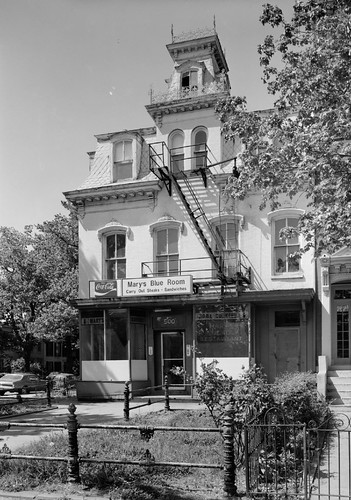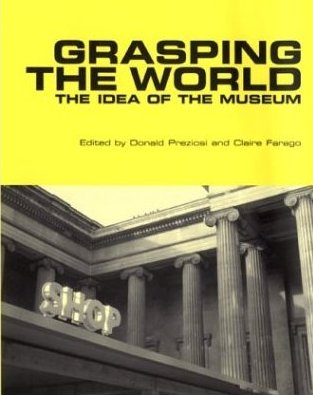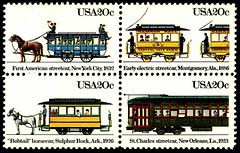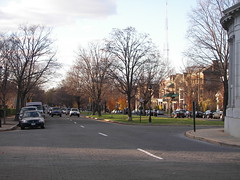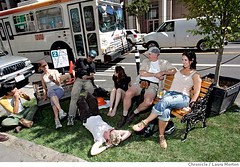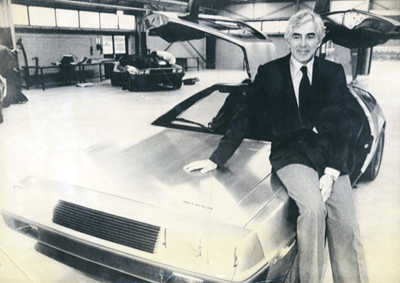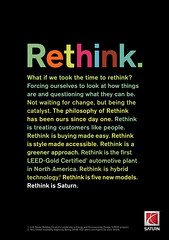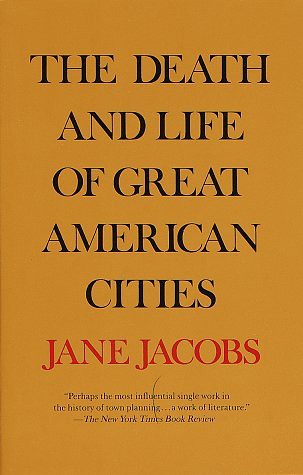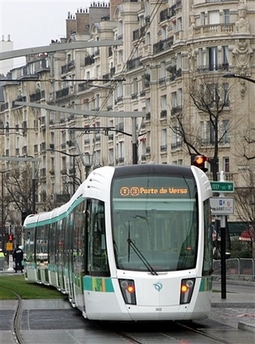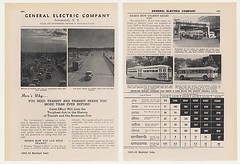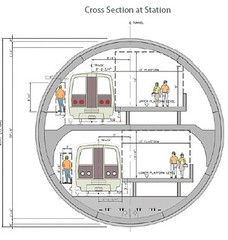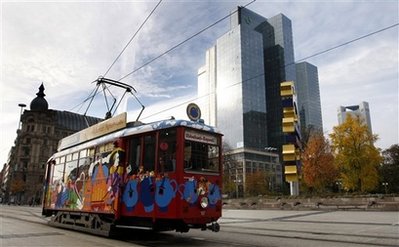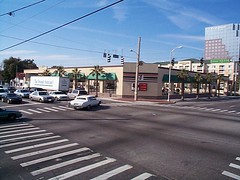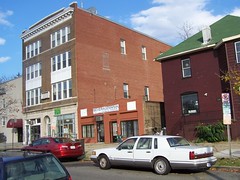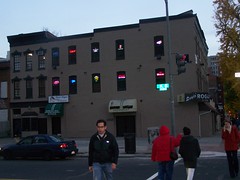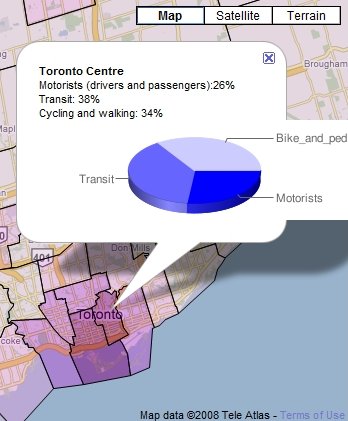(Lotsa) Stuff/Reading around
1. I just read a two month old issue of the Northwest Current only to learn that Georgetown University invited the community to a planning meeting on the Campus Plan. Since this was Saturday Nov. 9th, I definitely missed it.
- this article, "Georgetown University: New Preparations Begin For Campus Master Plan" discusses the process and has some links
- 2000 Campus Plan
2. Similarly, I noticed an ad for the Office of the People's Counsel "13th Energy Efficiency Expo" on Nov. 1st. Last Saturday (11/22) I attended a window and door insulation workshop outside in Lamont Park in Mt. Pleasant, sponsored by the DC Dept. of Consumer and Regulatory Affairs. It was very helpful and today we should be getting around to plastic wrapping some of our windows. Plus the Dept. of the Environment offers Home Energy Audits. And while at the DCRA workshop, I missed out on most of the Composting workshop conducted at the same time by Ed Bruske, author and one of the founders of the DC Urban Gardeners Group.
Why not all work together, and have one master "DC Green" conference every year sponsored by and organized in part by various DC government agencies, getting resources, ideas, options, and policies coordinated and focused on developing and extending best practices in DC. But including other groups, formal (i.e., Washington Parks and People) and informal (groups like Rooting DC and DC Urban Gardeners), not just government agencies.
Partly it could be like Arlington's "Car Free Diet" Expo, which works to move people away from single occupancy vehicle trips, and practical like the DCRA, composting, and OPC workshops, and broader, engaging in more topics, and working to organize people and increase their involvement in local civic affairs.
For example, the Department of Recreation and Parks in Baltimore does many things including organizing "Weed Warriors" where volunteers go to various Baltimore parks and pull weeds.
Speaking of a city being more citizen-focused, Baltimore has Greener Baltimore website and regular e-newsletter.
3. I am busier these days and have too many interests anyway to keep up on all things DC. Track Twenty-Nine is a blog by a UMD planning student who clearly is going to be a leading U.S. transportation planner after he graduates in May. He's writing more about WMATA specific things than I am, as is Greater Greater Washington.
He has two great posts, "Understanding the Blue Line Reroute" and "Streetcars, Version 2.0" on WMATA subway issues and DC streetcar issues respectively. (Even if I don't agree with all his particulars, everything he writes is thoroughly researched and very very good.)
AND, his maps are REALLY REALLY GREAT!
4. Speaking of Greater Greater Washington there is decent writing there on the historic preservation presentation on modernism, ""Persuading" or "evaluating"? Part of the problem with the analysis though is mixing places, DC preservation law is specifically related to DC and therefore doesn't necessarily consider "all" of the works within a particular architectural style or the body of work by a particular architect. Therefore, the GSA example isn't fully relevant to how DC should or does weigh similar issues, but is still worth thinking about.
5. Awhile back, the District Extra section of the Post has a piece titled "Fenty Isn't Czar Of the Rent Czar" which has a section about how DC City Council said no to Allen Lew, currently in charge of school reconstruction (ex-responsible for the construction of the Nationals Stadium) taking over responsibility for construction of Parks and Recreation facilities.
Actually I think the city is right in believing that contracting for and construction of buildings and management of the process is generally beyond the skill set of most DC agencies other than the Office of Property Management and the Department of Transportation (which builds roads, not buildings, but is still experienced in construction management).
This function should be consolidated within an agency that is focused on having expertise, not hacks, at the helm and in the line positions. The Fire Department's management of building-renovating fire stations, especially historic buildings, shows that it is easy even with the best of intentions for an agency with limited experience in construction to get overwhelmed.
6. The Post has an article on U.S. transportation policy, "From Funding to Infrastructure, New Transportation Secretary Faces A Hard Road Ahead" and the president of Amtrak, Alexander Kummant, resigned. The New York Observer had an interesting interview with him in the summer focused on expanding railroad capacity in NYC and the Northeast Corridor, "Alex Kummant, National Stationmaster."
The idea of planning mobility nationally in a substantive way (i.e., railroads for redundancy, railroads to move passengers from plane to train in particular corridors, railroad transportation within states and region) needs to happen. (Baltimore has some of the same issues as NYC with capacity limits. So does service from DC to Richmond.)
See the AP stories "Top Amtrak Executive Resigns" and "New Leader for Amtrak."
7. I can't claim I find most of the blogwriting in the region on retail to be all that insightful. The real problem comes down to volume as you need about 30,000 people to support 50,000 s.f. of retail. A decent neighborhood commercial district might be about that size or larger. So basically we have far more extant space than can be supported by the city's residential population (also note that the top 30% of households in terms of income make 50% of total consumer purchases), even when we add M-F daytime workers + visitors to the mix.
We need to work with commercial districts to harvest and leverage the opportunities that exist or in a sense, write them off, and accept that certain commercial districts such as the changing Columbia Heights or Friendship Heights (or Silver Spring, etc.) are "regional" intra-city commercial districts that provide a greater deal of retail that support a number of "satellite" neighborhoods, i.e., Ward 1's Columbia Heights supports many Ward 1 and Ward 4 neighborhoods, and those neighborhoods in turn are able to support a more limited array of service retail.
This comes to mind in part because of the AP story on the development of a film studio in Plymouth Rock, Massachusetts, "Historic Plymouth OKs building $488M movie studio." (The story ran in the Express.) It's all about agglomeration economies and having the support networks necessary to support business development and maintenance. It's going to be hard as hell for this area of Massachusetts to develop as a film center (especially when considering that Hollywood also competes with Vancouver and Toronto and even the place in Baja California, Mexico where part of the Titanic was filmed). Go with your strengths, and leverage your strengths, and admit your weaknesses and don't spend too much money trying to hide weaknesses as strengths...
In short, not all neighborhooods will be able to have thriving retail unless the city doubles in population and that is never going to happen, with or without opposition to various residential intensification projects.
-- See the webpage coverage from the Quincy Patriot-Ledger.
(And with a lot of money and connects, Hollywood East may be able to be successful. But I won't hold my breath.)

Plymouth Rock Studios executive Joseph DiLorenzo talks about the proposed movie studio complex in their Plymouth, Mass., offices Oct. 31, 2008. When built, the 240-acre studio complex will be the first independent film and television studio on the East Coast, featuring 14 soundstages, a 10-acre backlot, and all pre-production and post-production services.(AP Photo/Winslow Townson)
Labels: agglomeration economies, energy, environment, municipal government, provision of public services, retail, transit



